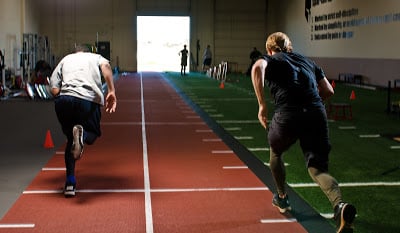
The sight of a hamstring muscle pull is pretty universal, the individual appears to have been shot in the back of the thigh. You have probably seen or can picture this sniper causing an athlete to pull up suddenly or even fall to the ground.
While an Achilles tendon rupture is similar picture, the hamstring is much more painful and unfortunately more common (12% of lower body injuries in sport) than its cousin below.
Contrary to common belief, the injury is rarely from inflexibility. Certainly static flexibility tests like touching your toes are a poor indicator, as these assessments are not specific to your sport and can easily be compensated by areas other than your hamstrings. Luckily, you can address and prevent any current hamstring issues with the same training stimulus, strength.
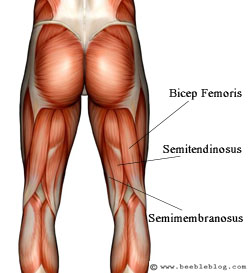
The word ham originally referred to the fat and muscle behind the knee and string refers to tendons, so the hamstrings are the string-like tendons felt on either side of the back of the knee. More specifically, the hamstrings are the three muscles of the posterior thigh shown above.
semitendinosus
semimembranosus
biceps femoris
The hamstrings are bi-articular, meaning they cross and act upon two joints, the hip and the knee. This 2 joint nature encourages hamstrings to transfer energy rather than create it, which is a job for the monoarticular (1 joint) muscles at the hip (gluteus maximus).
Thomas Myers calls these monoarticular muscles, locals, because they create energy, and the bi-articular muscles, trains, because they carry energy. This role clarification is critical because the main cause for hamstring injuries is that these muscles act as both trains and locals.
A 2012 review by Jurdan Mendiguchia in the British Journal of Sports Medicine, found no conclusive association on flexibility with hamstring injuries. However several correlations and theories showed promise when examining these athletes’ strength levels.
One 2008 study reported that elite sprinters who sustained acute hamstring injuries had reduced concentric hip extension strength. Basically, these athletes had weak gluteus muscles (Locals), transferring the burden of energy generation to the hamstrings (Trains), in addition to their normal role of force transfer.
However, the most widely studied explanation for hamstring injuries is eccentric strength because this lengthening phase is when the muscle strains occur in sprinting. A common example is when the athlete is reaching to cover more distance for each stride.
While this eccentric phase occurs in the skill of sprinting itself, the review found insufficient evidence for eccentric training to reduce hamstring injuries. The authors believe these studies were inconclusive because popular exercises like the glute ham raise and “Nordic Curls” only isolate the hamstring muscle. Such movements may strengthen these muscles in the similar contraction of sport injuries, but they keep the hip in a fixed position, unlike the dynamic hip positions found in sprinting and sport in general.
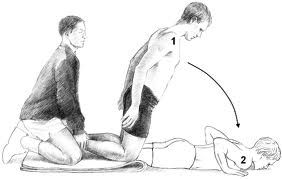
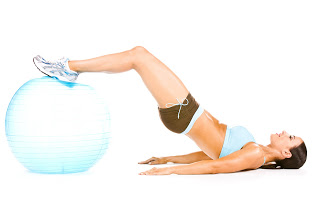
As you can see, strength is not just about hamstrings, or even just the lower body. The authors suggest a greater need for core strength. The increased stability of the abdominal muscles would alleviate the hamstrings need to stabilize the lumbo-pelvic-hip complex. Again, the same theme remains, hamstrings must be free from overwork.
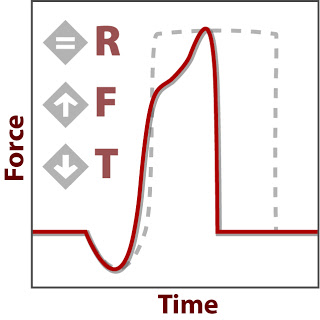
The biggest predictor of a hamstring injury is a previous hamstring injury. Hopefully, you do not have this risk factor, but either way, a Movement Signature can give insight into your risk. Our athletes with prior injury here, or those at risk, possess the flexed Movement Signature.
These athletes tend to be in anterior tilt; tight hip flexors and weak abdominals and glutes.The lacking variable is DRIVE of force production, which is produced by prolonging any movement with more extension, particularly at the hips.
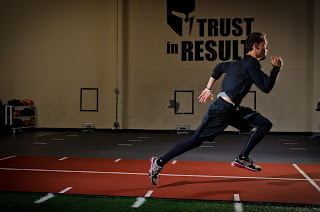
Our favorite complex to address these needs is a Front Split Squat paired with Acceleration Bounds. The Front Split Squat improves hip strength, eccentrically and concentrically, while integrating the lumbo-pelvic-hip complex to stabilize the additional weight from the barbell. Acceleration bounds also emphasize the hips and extension. But they also encourage sound running mechanics, as a global mechanism for any injury is poor skill execution.
Hamstring strains are also much more likely to occur in the latter part of games and matches. While the mechanisms are not clear, the cause is fatigue. Seems like a pretty simple fix…
Improve hip extension along with core stability, both eccentrically and concentrically
Perform the above with less rest (density training)
With training, as in sport, there is no isolation in victory.
Sugiura Y, Saito T, Sakuraba K, Sakuma K, Suzuki E. Strength deficits identified with concentric action of the hip extensors and eccentric action of the hamstrings predispose to hamstring injury in elite sprinters. J Orthop Sports Phys Ther. 2008 Aug;38(8):457-64.
Mendiguchia J, Alentorn-Geli E, Brughelli M. Hamstring strain injuries: are we heading in the right direction? Br J Sports Med. 2012 Feb;46(2):81-5.